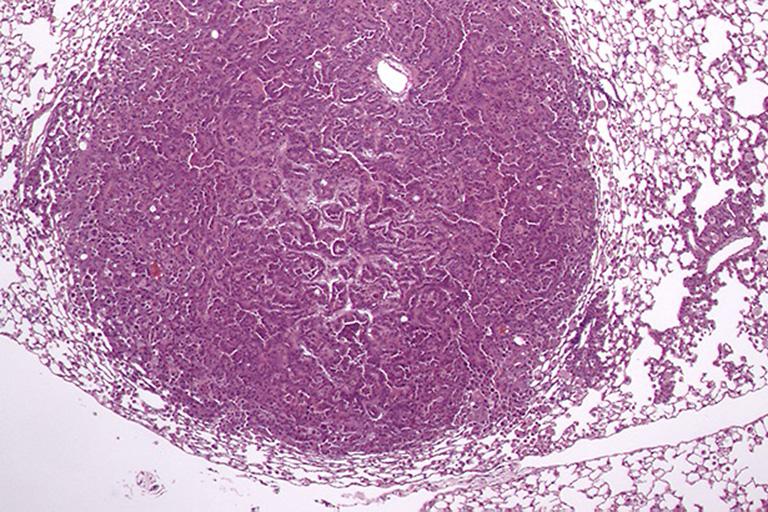The Kim laboratory examines the communication between epithelia and stroma through the lens of fundamental developmental pathways such as Hedgehog, Wnt, and Notch pathways. During development, these pathways mediate critical interactions between endoderm and mesenchymal germ layers that will arise to epithelium and stroma, respectively. The pathways mediate stem cell fate, proliferation, and differentiation.
Our laboratory studies these pathways and their interactions in the context of non-small cell lung cancer and head and neck cancers. We use genetic, chemical, and biochemical methods to dissect molecular mechanisms in cultured cells. Genetic and xenograft mouse models of cancer are used to model these interactions and to test in vivo effects of pharmacologic agents.
 Lung cancer in KrasLsl-G12D/+;Lkb1fl/fl mouse after infection with adenovirus-expressing Cre recombinase
Lung cancer in KrasLsl-G12D/+;Lkb1fl/fl mouse after infection with adenovirus-expressing Cre recombinase Novel Mouse Models of Head and Neck Cancers
Head and neck cancers encompass a heterogeneous group of cancers from multiple primary anatomic and tissue sites. Treatment consists of combination surgery, radiation, and chemotherapy with toxic side effects and often disfigurement. A dearth of research tools and reagents, including endogenous mouse models, has slowed advances in head and neck cancer diagnosis and treatment.
We have identified a novel endogenous mouse model of head and neck cancer that metastasizes to lymph nodes and the lung, one of the primary sites of metastases in human head and neck cancer.
This mouse model represents a new tool to dissect the molecular mechanisms and biological behavior of head and neck cancers, to identify prognostic and predictive biomarkers and to identify novel drug targets that may lead to new therapeutic regimens to treat HNC.
Interactions of Tumor Epithelia and Stroma
Most of the current therapies against epithelial cancers, including chemotherapy and targeted agents, are aimed at the tumor epithelia alone. This approach, however, ignores the stromal micro-environment in which tumors grow.
The stroma is a complex environment of fibroblasts, blood and lymphatic vessels, nerves, inflammatory cells, and extracellular matrix that provide the structure, nutrients, and growth factors for tumor growth, maintenance, and metastasis. Combination therapy targeting both tumor epithelial and stromal compartments may yield greater results than current therapeutics that target only the tumor epithelium.
We have focused on non-small lung cancer to study the tumor epithelia and stromal interactions. Through the lens of the Hedgehog (Hh) signaling pathway, we probe the molecular response of stromal fibroblasts in response to Hh ligands secreted by lung cancer epithelia and how these stromal responses alter the tumor epithelia for proliferation and metastasis.
We use genetic, chemical, and biochemical strategies in cultured lung cancer cell lines with autochthonous genetic mouse models of lung cancer for our studies.
Novel Mouse Models of Head and Neck Cancers
Head and neck cancers encompass a heterogeneous group of cancers from multiple primary anatomic and tissue sites. Treatment consists of combination surgery, radiation, and chemotherapy with toxic side effects and often disfigurement. A dearth of research tools and reagents, including endogenous mouse models, has slowed advances in head and neck cancer diagnosis and treatment.
We have identified a novel endogenous mouse model of head and neck cancer that metastasizes to lymph nodes and the lung, one of the primary sites of metastases in human head and neck cancer.
This mouse model represents a new tool to dissect the molecular mechanisms and biological behavior of head and neck cancers, to identify prognostic and predictive biomarkers and to identify novel drug targets that may lead to new therapeutic regimens to treat HNC.
.
Join Our Lab
There are frequent opportunities to join our lab.